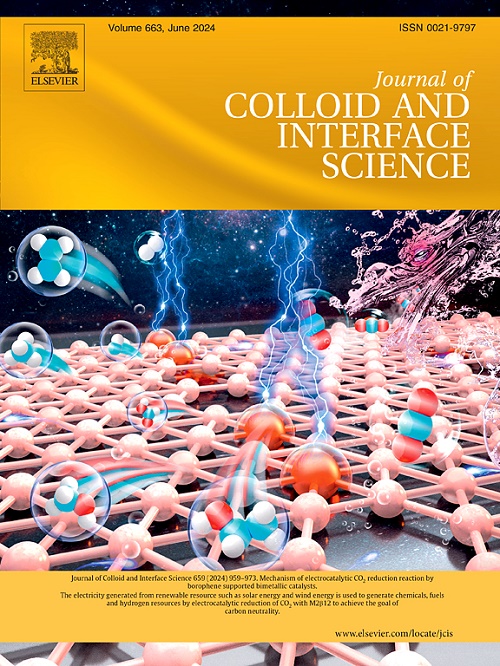K-Mn3O4-NCs@PANI nanochains for high-rate and stable aqueous zinc-ion batteries: A doping and morphology-tailored synthesis strategy
IF 9.4
1区 化学
Q1 CHEMISTRY, PHYSICAL
引用次数: 0
Abstract
Aqueous zinc ion batteries (AZIBs) are promising energy storage solutions due to their high energy density and safety. However, developing cathode materials that offer both high energy density and durability for Zn2+ ions storage remains challenging. Manganese (Mn) oxide-based cathodes have been developed for AZIBs due to their high discharge voltage and desirable capacity, but face challenges like poor conductivity, slow reaction kinetics, and dissolution during cycling. Doping, morphology/structure design, and protective layers are effective for enhancing the structure, conductivity, and electronic properties of Mn-based oxides. A synthetic strategy combining these methods for Mn3O4 cathodes is proposed for AZIBs. K+ ions doping in Mn3O4 (K-Mn3O4) can regulate local electronic structure, induce oxygen vacancies, improve conductivity, and provide more active sites for Zn2+ ions diffusion. Additionally, K-Mn3O4 nanochain (K-Mn3O4-NCs), with a unique chain-like nanostructure (NCs) and high aspect ratio, synthesized via Mn2+ ions chelation with nitrilotriacetic acid (NTA) and calcination, show reduced interparticle contact resistance, shorter Zn2+ ions diffusion length, and faster reaction kinetics. Meanwhile, the in-situ polymerized polyaniline (PANI) layer on K-Mn3O4-NCs shields against corrosion (K-Mn3O4-NCs@PANI), connects 1D K-Mn3O4-NCs into a continuous conductive network, suppresses volume expansion, and improves stability. Electrochemical analysis shows that K-Mn3O4-NCs@PANI exhibits higher stability and faster reaction kinetics due to a reduced bandgap, increased oxygen defects, and less coulombic repulsion between Zn2+ ions and Mn oxide hosts. The K-Mn3O4-NCs@PANI cathode achieved a high capacity of 510 mAh/g at 0.1 A/g and excellent rate capacity of 203.2 mAh/g at 5 A/g. After 20,000 cycles, it maintained a capacity of 90.3 mAh/g at 5 A/g, showing exceptional long-term stability with a minimal decay rate of 0.026 ‰ per cycle.

用于高倍率和稳定水性锌离子电池的 K-Mn3O4-NCs@PANI 纳米链:掺杂和形态定制合成策略。
锌离子水电池(AZIBs)具有高能量密度和安全性,是一种前景广阔的储能解决方案。然而,开发既能提供高能量密度又能耐久储存 Zn2+ 离子的阴极材料仍具有挑战性。锰(Mn)氧化物基阴极具有高放电电压和理想的容量,因此已被开发用于 AZIB,但面临着导电性差、反应动力学缓慢以及在循环过程中溶解等挑战。掺杂、形态/结构设计和保护层可有效增强锰基氧化物的结构、导电性和电子特性。本文为 AZIBs 提出了一种结合这些方法的 Mn3O4 阴极合成策略。在 Mn3O4(K-Mn3O4)中掺入 K+ 离子可以调节局部电子结构,诱导氧空位,提高导电性,并为 Zn2+ 离子的扩散提供更多的活性位点。此外,通过硝基三乙酸(NTA)螯合 Mn2+ 离子并煅烧合成的 K-Mn3O4 纳米链(K-Mn3O4-NCs)具有独特的链状纳米结构(NCs)和高纵横比,可降低粒子间接触电阻、缩短 Zn2+ 离子扩散长度并加快反应动力学。同时,K-Mn3O4-NCs 上的原位聚合聚苯胺(PANI)层可防止腐蚀(K-Mn3O4-NCs@PANI),将一维 K-Mn3O4-NCs 连接成连续的导电网络,抑制体积膨胀,提高稳定性。电化学分析表明,K-Mn3O4-NCs@PANI 具有更高的稳定性和更快的反应动力学,这是由于带隙减小、氧缺陷增加以及 Zn2+ 离子与氧化锰宿主之间的库仑斥力减小。K-Mn3O4-NCs@PANI 阴极在 0.1 A/g 条件下实现了 510 mAh/g 的高容量,在 5 A/g 条件下实现了 203.2 mAh/g 的优异速率容量。经过 20,000 次循环后,它在 5 A/g 时的容量仍保持在 90.3 mAh/g,显示出卓越的长期稳定性,每次循环的衰减率仅为 0.026 ‰。
本文章由计算机程序翻译,如有差异,请以英文原文为准。
求助全文
约1分钟内获得全文
求助全文
来源期刊
CiteScore
16.10
自引率
7.10%
发文量
2568
审稿时长
2 months
期刊介绍:
The Journal of Colloid and Interface Science publishes original research findings on the fundamental principles of colloid and interface science, as well as innovative applications in various fields. The criteria for publication include impact, quality, novelty, and originality.
Emphasis:
The journal emphasizes fundamental scientific innovation within the following categories:
A.Colloidal Materials and Nanomaterials
B.Soft Colloidal and Self-Assembly Systems
C.Adsorption, Catalysis, and Electrochemistry
D.Interfacial Processes, Capillarity, and Wetting
E.Biomaterials and Nanomedicine
F.Energy Conversion and Storage, and Environmental Technologies

 求助内容:
求助内容: 应助结果提醒方式:
应助结果提醒方式:


